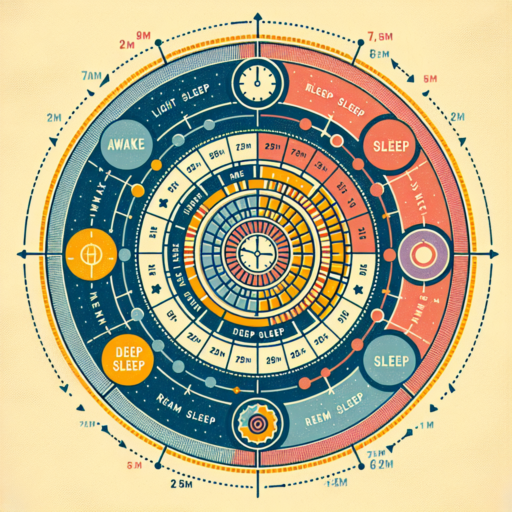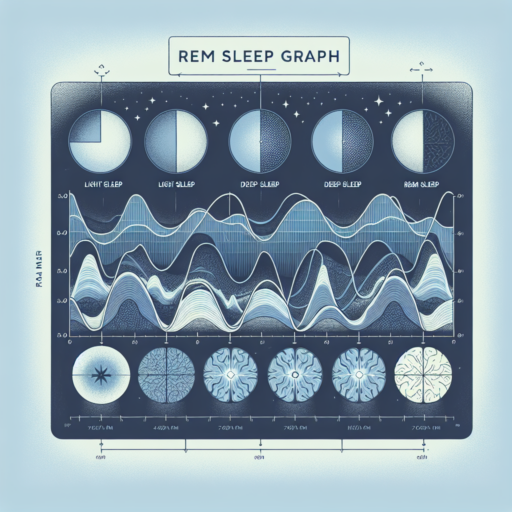Understanding the Basics: What Are Light Sleep and REM Sleep?
Sleep is a complex, yet essential part of our daily lives, playing a critical role in our health and well-being. It is composed of several cycles, each consisting of different stages including light sleep and Rapid Eye Movement (REM) sleep. Each of these stages serves unique and vital functions in rejuvenating the body and mind.
Light sleep, the first stage after we drift off, acts as a gateway between being awake and our deeper sleep phases. During this period, our heart rate and breathing slow down, and our muscles begin to relax. Although light sleep is considered a thinner, less restorative stage of sleep, it is crucial for memory consolidation and learning, serving as the foundation for a healthy sleep pattern.
On the other hand, REM sleep, often associated with vivid dreams, occurs cyclically throughout the night, roughly every 90 minutes. It is characterized by rapid movements of the eyes, increased brain activity, and temporary paralysis of the muscles, serving as a critical component for brain development, emotional regulation, and memory. REM’s role in processing and storing information makes it indispensable for cognitive functions and overall mental health.
The Science Behind Light Sleep: Functions and Importance
The intricacies of light sleep, a pivotal phase within the broader sleep cycle, are fundamental in understanding the holistic benefits of sleep on our well-being. When we slip into light sleep, our body initiates a series of crucial processes that lay the groundwork for deeper sleep stages. This phase is characterized by a slowdown in heart rate, reduced body temperature, and the start of brain wave patterns that are indicative of the earliest stages of sleep.
Key Functions of Light Sleep
One of the paramount functions of light sleep includes the role it plays in memory consolidation. During this phase, the brain begins the delicate process of sorting and storing memories, a task essential for learning and cognitive health. Additionally, light sleep sets the stage for the transition to deeper, more restorative sleep stages, facilitating bodily repair and growth through the release of critical hormones.
Importance of Light Sleep in Health and Well-being
Understanding the importance of light sleep reveals its indispensable role in our overall health. It’s not merely a transitional sleep phase but a foundation for both mental and physical rejuvenation. The efficiency of light sleep can significantly impact mood regulation, stress management, and even metabolic health. By optimizing light sleep, individuals may experience enhanced cognitive function, improved emotional balance, and a fortified immune system, showcasing the profound influence of light sleep on our daily lives.
Unlocking REM Sleep: What Happens During This Phase?
Understanding the REM (Rapid Eye Movement) sleep phase is essential for unlocking the mysteries of our sleep patterns. During REM sleep, the brain is almost as active as when we are awake, yet our bodies remain in a state of deep relaxation. This juxtaposition plays a crucial role in how we process emotions, consolidate memories, and rejuvenate our minds.
The Hallmarks of REM Sleep
- Increased Brain Activity: Despite being a phase of sleep, the brain’s activity levels are remarkably high, akin to when we are awake and alert.
- Vivid Dreams: REM is the phase in which most dreaming occurs. The vivid and often bizarre nature of these dreams is attributed to the heightened brain activity.
- Muscle Atonia: To prevent us from acting out our dreams, our bodies experience muscle atonia—a temporary paralysis of most voluntary muscles.
During REM sleep, our bodies undergo significant changes that are vital for optimal functioning. Eye movements become rapid and darting, heart rate and blood pressure rise, and breathing can become quick and irregular. These physiological changes, combined with the intense brain activity, suggest that REM sleep is a time of deep mental processing and physical restoration.
It’s during this mysterious phase that the brain sifts through the day’s experiences, deciding what to remember and what to forget. This makes REM sleep a critical component for emotional health, cognitive function, and overall well-being. Understanding its complexities not only fascinates but also encourages healthier sleep habits that support this vital phase.
Comparing Light Sleep vs REM Sleep: Key Differences
Understanding the key differences between light sleep and Rapid Eye Movement (REM) sleep is crucial for grasping how sleep cycles impact overall health and well-being. While both stages are essential components of a healthy sleep pattern, they serve distinct functions and characteristics that set them apart. Light sleep acts as a gateway to deeper sleep stages, promoting body relaxation and recovery, whereas REM sleep is often associated with dreaming and plays a critical role in emotional regulation and memory consolidation.
Duration and Frequency in the Sleep Cycle
The duration and frequency of light sleep and REM sleep vary significantly throughout the night. Initially, individuals spend a considerable amount of time in light sleep, which constitutes about 50-60% of total sleep time. As the night progresses, the duration of REM sleep periods increases, especially in the second half of the sleep cycle. Typically, REM sleep stages become longer, culminating in a REM period that can last up to an hour.
Physiological and Cognitive Effects
The physiological and cognitive effects of light sleep and REM sleep are markedly different. During light sleep, the body experiences a reduction in heart rate and breathing, preparing the individual for deeper sleep stages. In contrast, REM sleep is characterized by increased brain activity, to the extent that brain patterns can resemble wakefulness. This heightened brain activity during REM is thought to be responsible for vivid dreams and is essential for processing emotions and consolidating memories. Additionally, memory consolidation during REM sleep is critical for learning and long-term memory formation.
How Do Light Sleep and REM Sleep Affect Your Health?
Understanding the impact of different sleep stages, particularly light sleep and REM (Rapid Eye Movement) sleep, on your health is crucial to improving overall well-being. Both stages play unique roles in our sleep cycle, each contributing to the body’s recovery and functioning in distinct ways.
During light sleep, which constitutes the majority of our sleep time, your body begins the process of physical and mental relaxation. It is in this stage that the heart rate slows, muscles relax, and the body’s energy is replenished. Light sleep acts as a gateway to the deeper, more restorative stages of sleep and is important for memory consolidation and learning.
REM sleep, on the other hand, is when the brain is most active during sleep, similar to when it’s awake. This stage is crucial for emotional regulation, brain development, and memory. It is during REM sleep that the brain processes and integrates experiences and information from the day into long-term memory. A lack of REM sleep can lead to difficulties in concentrating, mood swings, and decreased cognitive performance.
Both light sleep and REM sleep are essential components of a healthy sleep cycle, contributing to our physical, mental, and emotional health in meaningful ways.Under the
The Impact of Sleep Cycles on Dreaming and Memory
, researchers have delved deep into understanding how different stages of sleep contribute to various aspects of cognitive functioning. The relationship between sleep cycles, particularly Rapid Eye Movement (REM) sleep, and Non-REM (NREM) sleep, plays a pivotal role in dreaming and memory consolidation. During the NREM stage, the brain processes and stores new information, which is crucial for learning and memory. On the other hand, REM sleep, often associated with vivid dreams, is thought to contribute to the processing of emotional memories and problem-solving.
Studies have shown that disruptions in these sleep cycles can significantly impact an individual’s ability to retain new information and process emotional experiences. For instance, a lack of REM sleep has been correlated with reduced capacity to remember complex tasks or solve creative problems. This linkage underscores the importance of quality sleep for cognitive health and emotional well-being.
Furthermore, dreaming during REM sleep serves as a psychological thermostat, regulating emotions and contributing to emotional recovery. This process of emotional adjustment during our dreams is thought to aid in memory formation, by integrating new experiences with past memories. The intricate dance between sleeping and dreaming phases therefore not only rejuvenates the mind but also plays a crucial role in our ability to learn, remember, and regulate emotions.
In exploring the impact of sleep cycles on dreaming and memory, it’s evident that these components of our nightly rest are interwoven in complex and vital ways. Understanding these connections can provide insights into improving cognitive function, emotional health, and overall well-being through better sleep practices.
Optimizing Your Sleep: Tips for Balancing Light and REM Sleep
Understanding the intricate balance between light exposure and REM sleep is crucial for optimizing sleep quality. The body’s internal clock, or circadian rhythm, is significantly influenced by light, impacting the duration and quality of REM sleep phases. This article offers strategic advice on harmonizing these elements to enhance sleep efficiency.
Regulating Light Exposure Before Bedtime: Diminishing exposure to bright lights and blue light-emitting devices at least an hour before bedtime can significantly improve the transition into REM sleep. The suppression of blue light, often emitted by smartphones and computers, aids in the natural production of melatonin, the hormone responsible for sleep regulation.
Creating a Sleep-Conducive Environment
- Utilize low-wattage bulbs with warm light tones to maintain a calm sleep atmosphere.
- Consider the use of blackout curtains or eye masks to block external light sources, further enhancing your sleep sanctuary.
Mindful management of your light exposure patterns and optimizing your bedroom environment are pivotal steps towards achieving a balanced REM sleep cycle. Integrating these practices into your nightly routine can lead to profound improvements in both sleep quality and overall well-being.
Tracking Your Sleep Patterns: Tools and Technologies
Understanding and improving your sleep quality can dramatically impact your overall health and well-being. Today’s advancements in technology have made it easier than ever to track your sleep patterns, providing insights that can lead to better sleep hygiene. Various tools and technologies are now available, ranging from wearable devices to smartphone applications, each offering unique features to help you understand your sleeping habits better.
Wearable Devices for Sleep Monitoring
Wearable devices, such as smartwatches and fitness trackers, have become increasingly popular for tracking sleep patterns. These devices use sensors to monitor your movements and heart rate throughout the night, providing data on sleep duration, sleep stages, and restfulness. Brands like Fitbit, Garmin, and Apple offer sleep tracking features in their devices, highlighting sleep quality scores to gauge the effectiveness of your rest.
Smartphone Apps: A Convenient Option
For those who prefer not to wear a device to bed, smartphone apps present a convenient alternative. Apps like Sleep Cycle and Sleep as Android utilize the phone’s accelerometer to monitor sleep patterns, offering insights into sleep quality, snoring patterns, and sleep cycles. These applications provide personalized tips and recommendations based on your sleep data, helping to improve your sleep hygiene without the need for specialized equipment.
Ultimately, the choice of tool or technology for tracking your sleep patterns depends on your personal preference and the depth of data you wish to obtain. Whether you opt for the detailed analysis provided by wearable devices or the convenience of smartphone apps, understanding your sleep behavior is a crucial step towards achieving better sleep health.
Common Misunderstandings About Light Sleep and REM Sleep Debunked
When it comes to sleep, many of us have fallen for misconceptions that impact our understanding of what makes for a good night’s rest. Two of the sleep stages often misunderstood are light sleep and REM (Rapid Eye Movement) sleep. Each plays a critical role in our sleep cycle, yet, myths surrounding them cloud their importance.
Myth 1: Light Sleep Isn’t Important
One common misunderstanding is that light sleep isn’t as important as deep or REM sleep. However, light sleep serves as the entry point to the sleep cycle, preparing our bodies for deeper sleep stages. It’s during this time that the body begins to relax, with heart rates slowing and body temperature dropping. Dismissing the significance of light sleep overlooks its role in physical restoration and memory consolidation.
Myth 2: REM Sleep is Only for Dreaming
Another myth is that REM sleep’s sole purpose is for dreaming. While it’s true that most vivid dreams occur during REM sleep, its functions extend beyond dreams. REM sleep is crucial for processing emotions, consolidating memories, and cognitive restoration. It’s a period of high brain activity, where the brain sorts and stores information from the day. Neglecting the multifaceted roles of REM sleep simplifies its complexity and undervalues its importance in emotional and mental health.
No se han encontrado productos.
Improving Sleep Quality: Professional Advice on Managing Light and REM Sleep
Obtaining a restful night’s sleep is pivotal for overall health and well-being. Specialists stress the importance of managing environmental light and understanding the phases of REM sleep as vital components in enhancing sleep quality. Tailoring your sleep environment and habits to support these can lead to significant improvements in how rested you feel each morning.
Managing Light Exposure for Better Sleep
One critical aspect that experts emphasize for improving sleep quality is light management. Exposure to light plays a crucial role in regulating our body’s internal clock, or circadian rhythm, which in turn influences our sleep patterns. Minimizing exposure to blue light emitted by screens well before bedtime is recommended to prevent sleep disturbances. Additionally, making use of dim lighting in your living spaces as you approach bedtime can significantly enhance your body’s readiness for sleep.
Understanding and Optimizing REM Sleep
REM sleep, or Rapid Eye Movement sleep, is another cornerstone of sleep quality that professionals focus on. This phase of sleep is responsible for processing emotions, consolidating memories, and rejuvenating the mind. Optimizing sleep schedules to support uninterrupted, quality REM sleep involves maintaining consistent sleep and wake times. Avoiding stimulants like caffeine and alcohol close to bedtime can also assist in achieving more profound and restorative REM sleep cycles.




